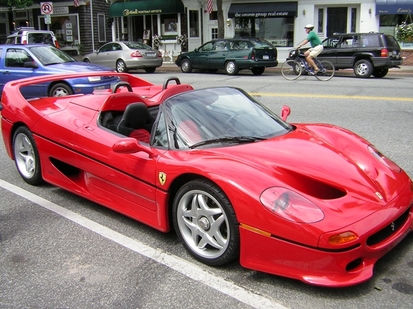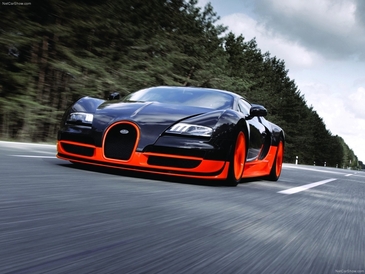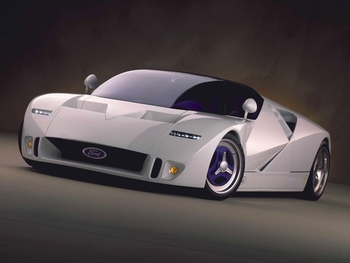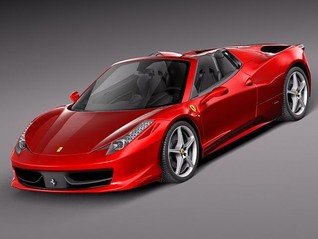What more can we say about the Koenigsegg CCX? It’s a rolling work of art designed by Sven-Harry Akesson, who also designed the very first Koenigsegg, the CC. With an engine block cast by Grainger and Worrall, a company that produces drivetrain components for Formula One cars, you can rest assured that the CCX is a fast car, running from 0-60 in a scant 3.2 seconds with a top speed of approximately – it has never been verified – 250 mph.
As one of eight ‘Rival Cars’ in SHIFT 2 Unleashed, the Ford Mustang RTR-X – with ‘RTR’ standing for ‘Ready to Rock’ – is possibly the most unique in the game. Designed by Vaughn Gittin Jr., the RTR-X is a modern drift version of the 1969 Mustang. First unveiled at SEMA 2010, the RTR-X has tons of style, with its gloss black paint matched up with florescent green trim pieces to create a true Team Need for Speed design.
Screenshot - Lexus LFA from shift 2 unleashed
With their staggering sticker prices, most supercars cater to the upper crust of society, the rich, famous and elite. The Lexus LFA takes that attitude one step further: it’s so exclusive that nobody can buy it without first signing a two-year lease. Toyota took this direction with their 552-horse V10 halo car in an attempt to dissuade speculators, who buy limited-production vehicles and wait for their value to go up before re-selling, a common occurrence with the McLaren F1. To qualify for the lease program, you need to put down $298,000 at signing and cough up an additional $12,400 in monthly payments. It sounds expensive, but once you take the LFA out in SHIFT 2 UNLEASHED, you may have the sudden urge to start clipping coupons.
 Manufacturer Ferrari
Production 1995–1997
(349 produced)
Assembly Maranello, Italy
Predecessor Ferrari F40
Successor Enzo Ferrari
Body style Berlinetta/Barchetta
Layout RMR layout
Engine 4.7 L V12
Wheelbase 2,580 mm (101.6 in)
Length 4,480 mm (176.4 in)
Width 1,986 mm (78.2 in)
Height 1,120 mm (44.1 in)
Curb weight 1,230 kg (2,712 lb)
Related Ferrari F50 GT
The Ferrari F50 is a mid-engined range-topping sports car made by Ferrari. The F50 was introduced in 1995 to celebrate the company's 50th anniversary. The car is a two door, two seat convertible with a removable hardtop. It has a 4.7 L naturally aspirated 60-valve V12 engine that was developed from the 3.5 L V12 used in the 1992 Ferrari F92A Formula One car.
Only 349 cars were made. The last F50 was produced in Maranello, Italy in July 1997.
The F50's engine predated the car; it was used in the Ferrari 333 SP for the American IMSA series in 1994, allowing it to become eligible for the stock engine WSC category.
Racing
Following the motorsport theme, Ferrari developed the F50 GT, a prototype based on the F50 that was built to compete in GT1-class racing. The car had a fixed roof, large rear spoiler, new front spoiler and many other adjustments. The 4.7 litre V12 engine was tuned to generate around 750 bhp (559 kW). In testing in 1996 the car proved to be quicker even than the 333SP, but this went unnoticed as Ferrari cancelled the F50 GT project, instead focusing on Formula One. Ferrari sold off the three complete chassis that were built–the test car 001, 002 and 003. Chassis 002 and 003 had bodies fitted before being sold. The remaining three tubs were apparently destroyed.
A custom-made F50 variant named the Bolide was commissioned by the Sultan of Brunei in 1998 and delivered in the same year.[citation needed] It used the F1 derived V12 engine and the same chassis, but was completely redesigned due to the monocoque construction of the body on the F50.One car was produced in the coupe configuration. Very few images and no official performance statistics of this car are available. At least one car was produced in RHD for the sultan, and was subsequently bought by a collector in Ireland.
Engine weight: 436.5 lb (198.0 kg)
Timing gear: 5 valve/cyl (3 intake, 2 exhaust), 4 overhead camshafts (2 per cylinder bank) driven by low-noise Morse chain
Displacement: 4698 cc/286.68 ci
Max. power: 520 PS (382 kW; 513 hp) @ 8000 rpm
Max. torque: 347 lb·ft (470 N·m) @ 6500 rpm
Power/Disp.: 109.1 bhp/litre
Colour popularity
Rosso Corsa (Red): 302
Giallo Modena (Yellow): 31
Rosso Barchetta (Dark red): 8
Argento Nurburgring (Silver): 4
Nero Daytona (Black): 4
 Manufacturer Bugatti Automobiles and Volkswagen Group (parent company)
Production 2005–2011 (last 16.4 sold)
2008-present (Grand Sport)
2010-present (Super Sport)
Assembly Molsheim, Alsace, France
Predecessor Bugatti EB110
Class Sports car
Body style Standard: 2-door coupé
Variant: targa top
Layout Longitudinal mid-engine,
permanent 4WD
Engine Standard:
8.0 L (488 cu in) W16 quad-turbocharged 1,001 PS (736 kW; 987 bhp)[1]
Super Sport:
1,200 PS (883 kW; 1,184 bhp)[1][2]
Transmission 7-speed DSG sequential
Wheelbase 2,710 mm (106.7 in)
Length 4,462 mm (175.7 in)
Width 1,998 mm (78.7 in)
Height 1,159 mm (45.6 in)
Kerb weight 1,888 kg (4,162 lb)
Designer Jozef Kaban[3]
Super Sport edition
The Veyron Super Sport features an engine power increase from the standard 1,001 metric horsepower (736 kW; 987 bhp) to 1,200 metric horsepower (883 kW; 1,184 bhp) and torque of 1,500 N·m (1,100 ft·lbf) and a revised aerodynamic package.[4] It was shown publicly for the first time at the Pebble Beach Concours d'Elegance in August 2010.[3]
Bugatti's official test driver Pierre Henri Raphanel drove the Super Sport version of the Veyron on Volkswagen's Ehra-Lessien high-speed test track to establish the car's top speed. With representatives of the Guinness Book of Records and German Technical Inspection Agency (TÜV) on hand, Raphanel made passes around the big oval in both directions achieving an average maximum speed of 431.072 km/h (267.856 mph).[15] Once produced for sale, the first five Super Sports will sport the same black and orange finish as the first production car, which was used to set the speed record, and all production models will be electronically limited to 415 km/h (258 mph) to protect the tyres.[4]
[edit] Top speed
German inspection officials recorded an average top speed of the original version of 408.47 km/h (253.81 mph)[5] during test sessions on the Ehra-Lessien test track on 19 April 2005.
This top speed was verified by James May on Top Gear in November 2006, again at Volkswagen Group's private Ehra-Lessien test track. May noted that at top speed the engine consumes 45,000 litres (9,900 imp gal) of air per minute (as much as a human breathes in four days). The Veyron has the highest top speed of any street legal production car. Back in the Top Gear studio, co-presenter Jeremy Clarkson commented that most super-cars felt like they were shaking apart at their top speed, and asked May if that was the case with the Veyron at 407 km/h (253 mph). May responded that no, the Veyron was very controlled, and only wobbled a tiny-bit when the air-brake deployed. May further commented “Absolutely yeah, it’s totally undramatic. But I would give you a bit of a warning, It’s a bit disorientating doing that sort of speed, because after I came off the banking, I was slowing down to stop, and you know how you get a bit impatient and think ‘I’ll just open the door’, fortunately I looked back at the speedo, and I was still doing seventy.”[16]
On 4 July 2010, Bugatti's official test driver Pierre Henri Raphanel piloted the Super Sport edition and was clocked at an average of 431.072 km/h (267.856 mph) on the same track, taking back the title from the SSC Ultimate Aero TT as the fastest production vehicle of all time. The 431.072 km/h mark was reached by averaging the Super Sport's two test runs, the first reaching 427.93 km/h (265.90 mph) and the second 434.20 km/h (269.80 mph). The record run was certified by the German government and the Guinness Book of World Records.[17]
The car's everyday top speed is listed at 350 km/h (220 mph). When the car reaches 220 km/h (140 mph), hydraulics lower the car until it has a ground clearance of about 9 cm (3.5 in). At the same time, the wing and spoiler deploy. In this handling mode the wing provides 3,425 newtons (770 lbf) of downforce, holding the car to the road.[11]
For top speed mode the driver must, while at rest, toggle a special top speed key to the left of the driver's seat. A checklist then establishes whether the car and its driver are ready to attempt to reach 407 km/h (253 mph). If so, the rear spoiler retracts, the front air diffusers shut, and normal 12.5 cm (4.9 in) ground clearance drops to 6.5 cm (2.6 in).
 The Ford GT90 is a concept car manufactured by the Ford Motor Company. It was unveiled in January 1995 at the Detroit Auto Show as "the world's mightiest supercar". Claimed performance included a top speed 235 mph (378 km/h) from a 720 hp (537 kW;730 PS) quad-turbocharged V12 engine DOHC, the exhaust of which was claimed to be hot enough to damage the body panels, requiring ceramic tiles similar to those on the space shuttle to prevent this.
The mid-engined car is a spiritual successor to the Ford GT40, taking from it some styling cues, such as doors that cut into the roofline, but little else. All angles and glass, the Ford GT90 was the first Ford to display the company's "New Edge" design philosophy. The GT90 was built around a honeycomb-section aluminum monocoque and its body panels were moulded from carbon fiber.
The GT90 was built by a small team in just over six months and, as a result, borrowed many components from another high profile stablemate—the Jaguar XJ220. The all-round double wishbone suspension and the five-speed manual gearbox came from the Jaguar, while the engine was a siamesed 4.6L DOHC V8 block (from the Lincoln Mark VIII) with 2 cylinders cut off.
The GT90's 48-valve V12 was a six-litre engine which, if Ford had ever produced it in volume, might have produced up to 720 hp (537 kW), thanks to four Garrett AiResearch T2 turbochargers. The engine was based on the Ford Modular engine. Two Lincoln V8 engines each had portions removed, namely the last pair of cylinders from the rear of one engine and the first pair of cylinders from the front of the other engine and the cut down engines were welded together. In total, this yielded a 90-degree V12, with 90.2 mm bore and 77.3 mm stroke.
Jacques Nasser, then a Ford executive and eventually CEO, was very proud of the car, and kept a model of it on his desk, as seen in a documentary on the U.K. television network Channel 4 on the Firestone tire incidents.
It also appeared in the videogames Need for Speed II, Sega GT 2002, Ford Racing 2, Ford Racing 3, Gran Turismo 2, "Rush 2: Extreme Racing USA", TOCA Race Driver 2, TOCA Race Driver 3 and Project Gotham Racing 3.
 Manufacturer Ferrari
Production 2009-present
Model years 2010-present
Assembly Maranello, Italy
Predecessor Ferrari F430
Body style 2-seat Berlinetta
Layout Rear mid-engine, rear-wheel drive
Engine 4.5 L V8
Transmission 7-speed dual-clutch
Wheelbase 2,650 mm (104.3 in)[1]
Length 4,527 mm (178.2 in)[1]
Width 1,937 mm (76.3 in)[1]
Height 1,213 mm (47.8 in)[1]
Curb weight 1,485 kg (3,274 lb)
Designer Pininfarina
Engine
The 458 Italia is powered by a 4.5 L (270 cu in) V8 engine derived from a shared Ferrari/Maserati design, producing 570 PS (419 kW; 562 hp) at 9,000 rpm (redline) and 540 N·m (398 lb·ft) at 6,000 rpm[4] with 80% torque available at 3,250 rpm.[3] The engine features direct fuel injection, which is a first for Ferrari mid-engine setups in its road cars.[3] The 4.5 L V8 in the 458 currently holds the world record for most power per liter in a naturally aspirated production car engine.[5]
[edit] Transmission
The only transmission available on the 458 is a dual-clutch 7-speed gearbox.[3] There is no traditional manual option, making this the fifth road-car after the Enzo, California, Challenge Stradale and 430 Scuderia not to be offered with Ferrari's classic gated manual. It is the first mainstream model to not be offered with a manual transmission.
Ferrari unveiled the 458 Spider at the 2011 Frankfurt Motor Show. This convertible variant of the 458 Italia features an aluminium retractable hardtop which, according to Ferrari, weighs 25 kilograms (55 lb) less than a soft roof such as the one found on the Ferrari F430 Spider, and can be retracted in 14 seconds.[17][18] The engine cover has been redesigned to cope with the retractable roof system. Ferrari plans to make 1,500-2,000 458 Spiders every year.
Sedikit preview tentang progres yang sudah saya lakukan sekarang.Semua lubang di pintu sudah ok semuanya tinggal dummy,rotation dan beberapa texture yang belum di buat.
Progress: 20%
Dijanka siap: Antara 18 ke 20 bulan 2.
Glad to announces my next modifications is LP 560-4 GT3.Which will take around 20 days to finished
Progress: 2%
Expect Finished: 18 to 20.02.2012
|